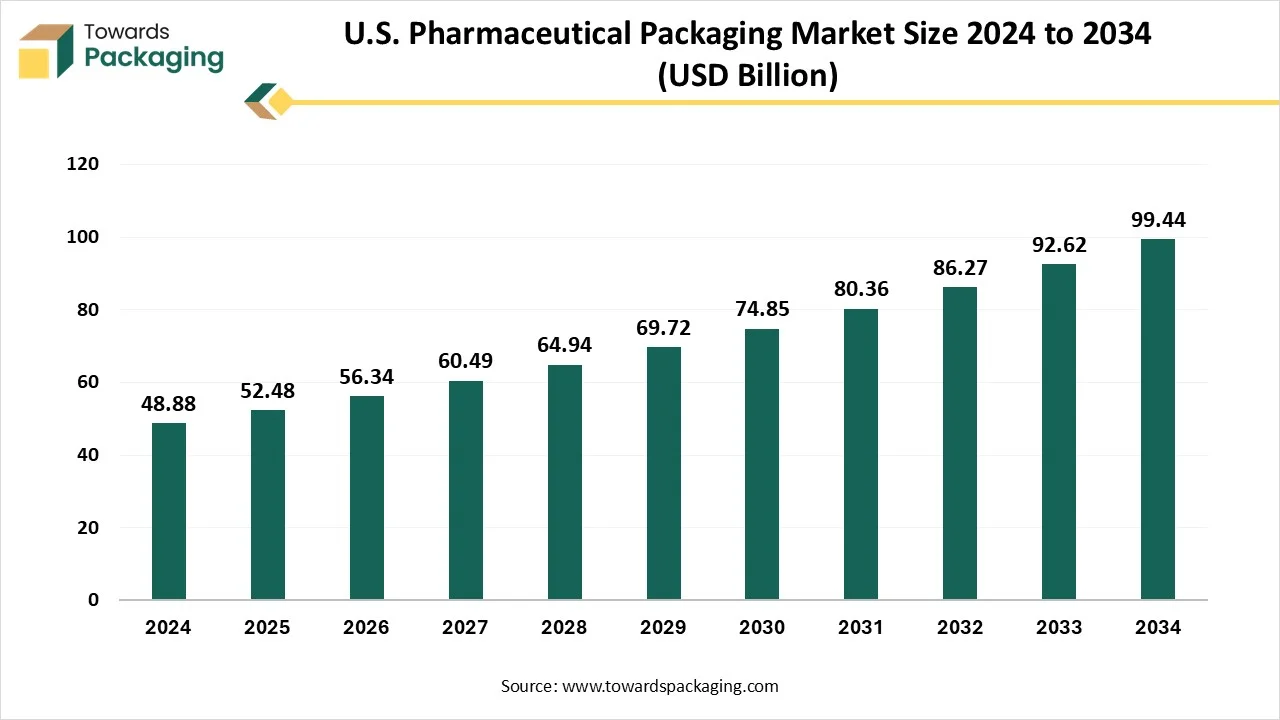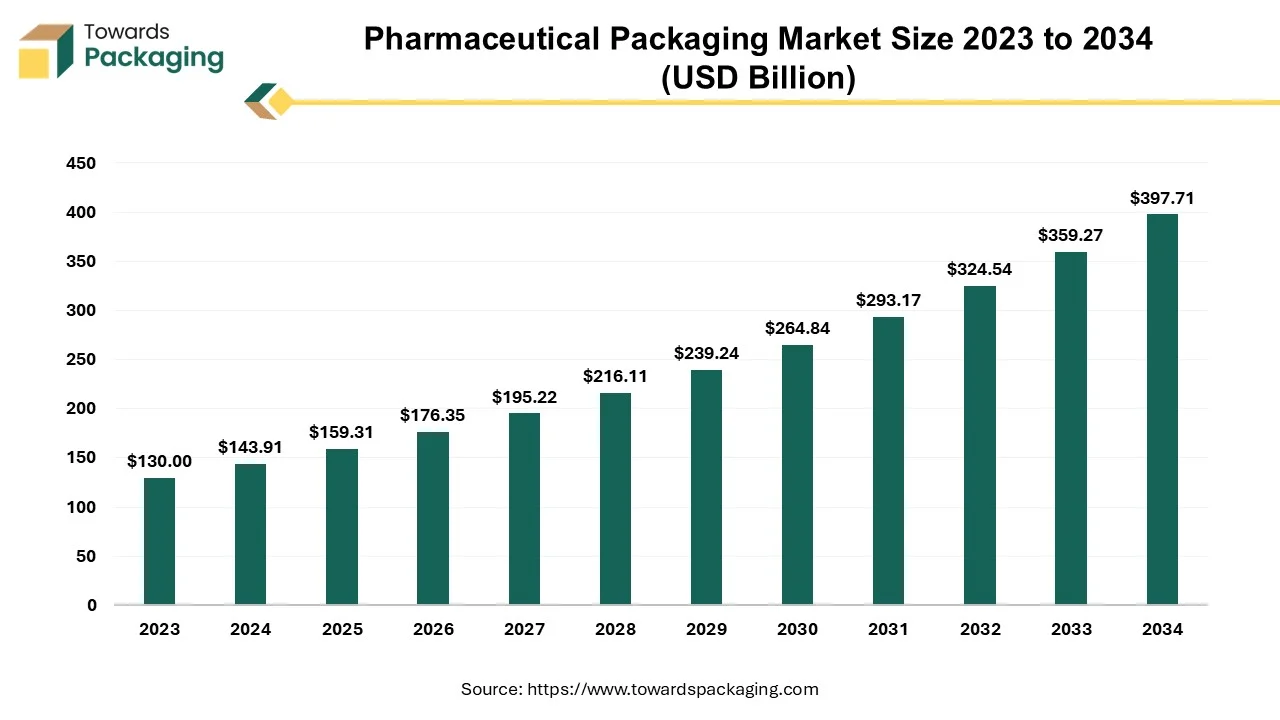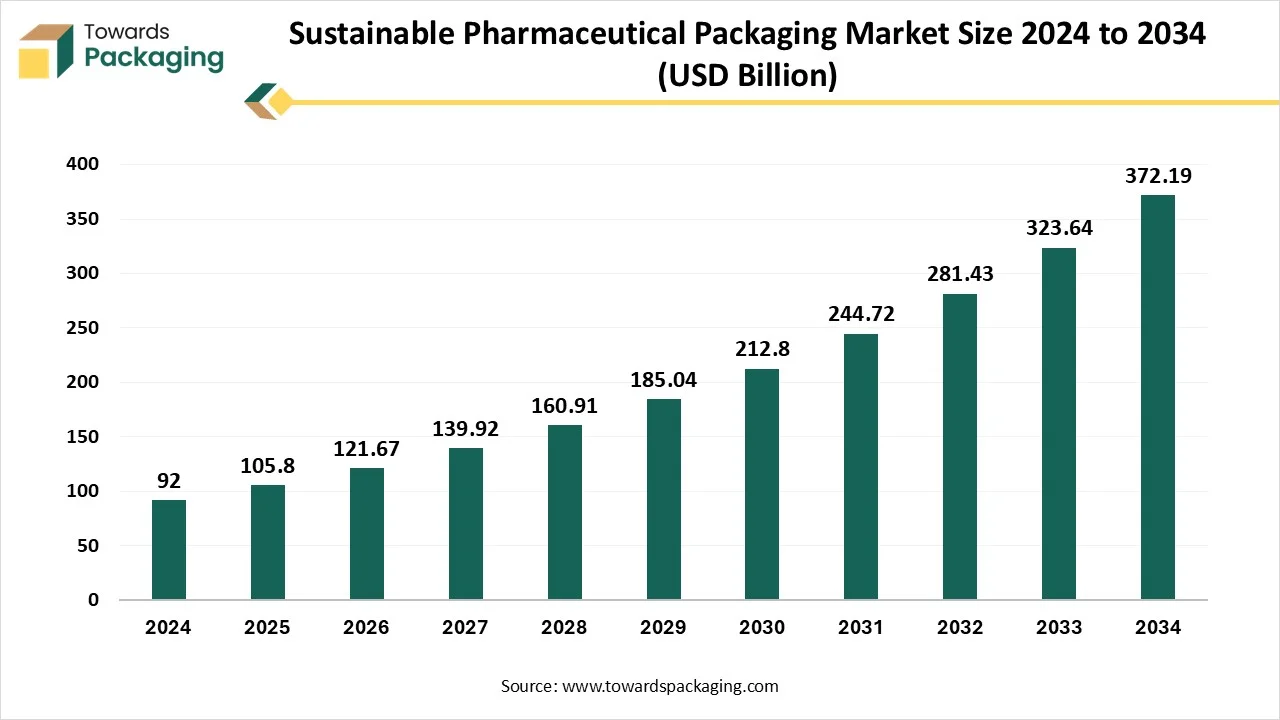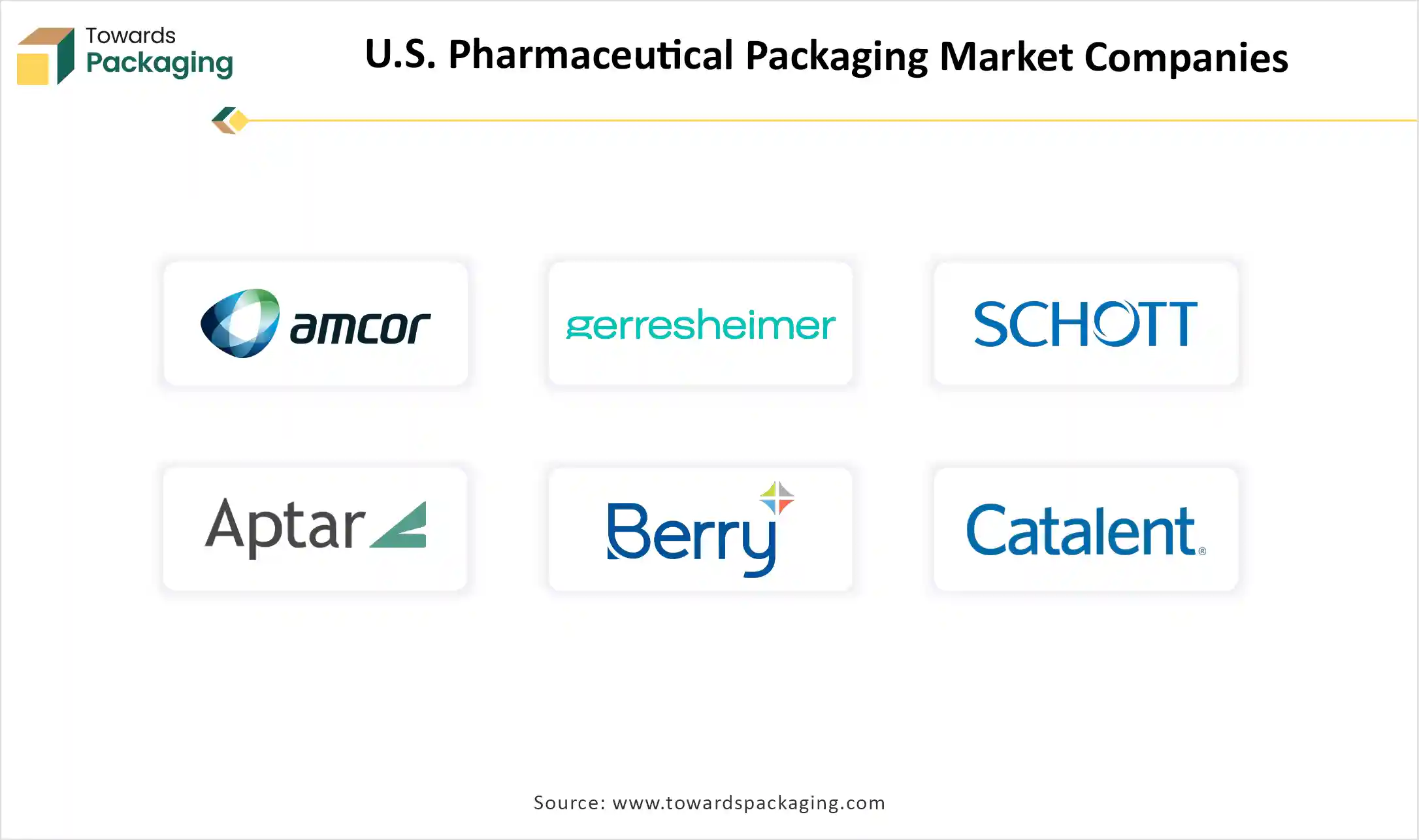December 2025
The U.S. pharmaceutical packaging market is projected to expand from USD 52.48 billion in 2025 to USD 99.44 billion by 2034, growing at a strong 7.36% CAGR. We cover every major insight including market trends (sustainable materials, smart packaging, biologics growth), segment data (primary packaging 70%, plastic 60%, oral drugs 50%, conventional packaging 55%), and regional trends across NA, EU, APAC, Latin America, and MEA. Our research also includes competitive analysis of major players such as Amcor, Gerresheimer, Schott, BD, West, and Catalent, along with value chain mapping, trade flow statistics, importer–exporter insights, and detailed profiling of manufacturers and suppliers active in the U.S. and global market.

The U.S. pharmaceutical packaging market refers to the industry that develops and supplies packaging solutions specifically designed to protect pharmaceutical products during storage, handling, and transportation while ensuring safety, efficacy, regulatory compliance, and patient convenience. This market includes primary packaging (direct contact with the drug), secondary packaging (external containers/labels), and tertiary packaging (bulk handling).
In today's rapidly evolving technological landscape, AI integration holds the potential to reshape the entire landscape of the U.S. pharmaceutical packaging market. The integration of AI technologies in pharmaceutical packaging marks a significant shift towards more efficient, accurate, and innovative packaging practices. Machine Learning algorithms assist vision system experts in identifying and sorting false ejects. In the pharmaceutical packaging, AI integration is paving the way for biodegradable materials and alternatives that can significantly lower greenhouse gas emissions and promote circularity. By harnessing the power of AI algorithms, researchers can develop sustainable packaging materials that reduce wastage, conserve resources, and protect the Earth for future generations.
How is the Increasing Demand for Biopharmaceuticals Impacting the Growth of the Market?
The rising demand for biopharmaceuticals is expected to boost the growth of the U.S. pharmaceutical packaging market during the forecast period. Biopharmaceuticals, which focus on biologics such as monoclonal antibodies, vaccines, gene therapies, and others, require specialized packaging solutions, such as tamper-evident packaging and temperature-controlled packaging to maintain both safety and efficacy. Specialized packaging solutions are increasingly gaining immense popularity in the pharmaceutical industry, with the rise of biopharmaceuticals.
Biologics are sensitive, complex, and require advanced packaging to safeguard therapeutic benefits. Biologics are generally produced in large quantities that are transported in bulk to the fill & finish site. The drug delivery of these bulk drug substances requires efficient and specialized packaging solutions that assist in maintaining the appropriate temperature range during transit. In the production of pharmaceutical goods, complying with stringent guidelines such as current Good Manufacturing Practices, requiring certifications from the FDA is important to ensure the safety and quality of drug substances and medical devices. Single-use bags offer high-quality control and protection for high-value biologics and minimize the risk of contamination.
Surge in Raw Material Prices and High Investment
The rising raw material costs and high investment in advanced pharmaceutical packaging technology are anticipated to hinder the market’s growth. The modern technologies, such as serialization and track-and-trace systems, require a high upfront investment. These factors can significantly enhance the production costs and may restrict the market entry for small and medium-sized companies. In addition, rising cases of counterfeit drugs and fake packaging may restrict the expansion of the global U.S. pharmaceutical packaging market.
Increasing Focus on Sustainable and Eco-friendly Pharmaceutical Packaging Solutions
The rising focus on sustainable and eco-friendly packaging solutions is projected to offer lucrative growth opportunities to the growth of the U.S. pharmaceutical packaging market in the coming years. In the pharmaceutical industry, sustainable pharmaceutical packaging focuses on reducing environmental impact throughout the product lifecycle, from production to disposal. This involves using biodegradable, recyclable, or compostable packaging materials to align with the circular economy principles of the country.
Consumers are increasingly preferring to replace conventional packaging materials, such as plastics and polystyrene, which accumulate pollution levels, landfill overflow, and marine debris, posing significant threats to human health and ecosystems. Plastic takes nearly 1000 years to decompose. The adoption of eco-friendly packaging solutions by pharmaceutical companies assists in lowering their carbon footprint and becoming more environmentally conscious. Moreover, the rising regulatory pressure and surge in environmental concerns have encouraged pharma companies to invest in sustainable packaging solutions.
The conventional packaging segment dominated the market with the largest share in 2024. Conventional pharmaceutical packaging generally involves primary, secondary, and tertiary packaging to safeguard the drugs from contamination, physical damage, and other environmental factors. These packaging ensures secure transport and protects against pharmaceutical products during handling, storage, and facilitates easier logistics for high-volume orders.
On the other hand, the smart packaging (RFID, sensors, temperature monitoring) segment is expected to grow at a significant rate, owing to the increasing need for product authentication, stringent government framework, and rising focus on improving patient safety. Smart packaging ensures the integrity of drugs and reduces the risk of counterfeit drugs reaching the market by ensuring that each package verifies its authenticity. RFID chips assist in tracking the medications throughout the supply chain. Such tools support compliance with serialization requirements like those introduced under the DSCSA.
The primary packaging segment held a dominant presence in the U.S. pharmaceutical packaging market in 2024. The growth of the segment is mainly driven by the rising demand for biologics, injectable drugs, and personalized medicines. Primary packaging directly holds control over the medication. Primary packaging efficiently protects the drug from contamination and various environmental factors like moisture, oxygen, and light while ensuring accurate dosing and safe handling. These packages comply with the U.S. regulatory requirements for safety and labeling. Labels include crucial information such as expiration, dosage, and product identification to support traceability and minimize errors. There are different types of primary packaging, including bottles, blister packs, vials & ampoules, syringes & cartridges, pouches, and tubes.
The syringes & cartridges sub-segment is growing rapidly, owing to the rising focus on patient safety, increasing need to comply with regulatory guidelines, and increasing demand for biologics requiring specialized storage and handling. In recent years, prefilled syringes and cartridges have gained immense popularity over traditional vials and syringes. Several companies operating in the U.S. are increasingly focusing on developing improved syringe and cartridge designs, particularly those for vaccines, biologics, and other home-based therapies.
Plastics dominated the U.S. pharmaceutical packaging market in 2024. Plastic packaging is widely used in the pharmaceutical industry owing to its durability, versatility, strength, durability, cost-effectiveness, mechanical strength, and stability. Pharmaceutical plastic packaging commonly includes bottles, pill bottles, dispensers, blisters, ampoules, and others. Some specific plastics like PP, PET, and HDPE are preferred for their unique properties, such as barrier protection, strength, versatility, and resistance to chemicals and the environment.
On the other hand, the biodegradable and polymer films segment is expected to grow at a notable rate during the forecast period, owing to the rising environmental and sustainability concerns. The surge in environmental issues and regulatory pressures is compelling pharmaceutical companies to adopt more eco-friendly packaging practices, such as recyclable, biodegradable, and compostable packaging materials, which significantly reduce packaging waste and promote environmental sustainability. Additionally, rapid advancement in material science and pharmaceutical packaging technologies is expected to further boost the market's expansion.
The oral drugs segment is expected to dominate the U.S. pharmaceutical packaging market. The growth of the segment is mainly fuelled by the increasing incidence of chronic diseases, a surge in healthcare expenditure, increasing focus on patient compliance and safety, and rising innovation in novel drug packaging systems. In addition, the increasing demand for child-resistant and tamper-evident features in packaging is anticipated to propel the growth of the segment during the forecast period.
On the other hand, the injectables segment is growing at the fastest CAGR owing to the rising prevalence of chronic diseases, surge in aging population, the increasing demand for biologics, and the growing need for safe and convenient packaging solutions. Chronic diseases such as cardiovascular diseases, diabetes, cancer, and immune disorders require long-term treatment, often administered through injectables. Biologics, including antibodies, vaccines, and gene therapies, play a crucial role in treating various chronic disorders, which require specialized packaging solutions that can maintain their stability and efficacy, as well as protection against contamination.
The pharmaceutical companies segment is dominating the market over the U.S. pharmaceutical packaging market in 2024, owing to the rapid expansion of the pharmaceutical industry, coupled with the increasing incidence of chronic diseases. Pharmaceutical companies in the U.S. heavily rely on efficient and specialized pharmaceutical packaging to ensure drug safety and efficacy. Packaging protects drugs from contamination, physical damage, degradation, and other environmental factors such as light, moisture, and oxygen.
On the other hand, the contract manufacturing organizations (CMOS) segment is expected to witness remarkable growth during the forecast period. CMOs are increasingly preferred when pharmaceutical companies plan to outsource drug production to third-party manufacturers. CMOs play a crucial role from drug formulation and production to packaging and distribution for pharmaceutical companies. These specialized services assist pharmaceutical companies in focusing on their core activities and cost optimization.
The global pharmaceutical packaging market is forecasted to expand from USD 159.31 billion in 2025 to USD 397.71 billion by 2034, growing at a CAGR of 10.7% from 2025 to 2034. The growth is mainly driven by the increasing need for safe and effective drug packaging due to rising demand for medicines worldwide. This is supported by advances in technology and stricter regulations ensuring product quality and patient safety.

A vital part of medicine delivery, pharmaceutical packaging guarantees the efficacy, safety, and integrity of pharmaceutical products for the course of their lifetime. Pharma packaging shields goods against deterioration, contamination, and other outside influences that could jeopardize patient safety and product quality by using specific materials and technology. Packaging acts as a protective barrier against temperature changes, moisture, light, and physical harm.
The sustainable pharmaceutical packaging market is expected to increase from USD 105.80 billion in 2025 to USD 372.19 billion by 2034, growing at a CAGR of 15% throughout the forecast period from 2025 to 2034. This market proliferates due to the growing necessity for sustainable packaging, as the demand for pharmaceutical products is increasing, and the massive use is creating waste management issues due to non-biodegradable packaging. All these factors are going to show huge growth in the upcoming times in the sustainable pharmaceutical packaging market.

Globally, many chronic diseases are prevalent, and the requirement for health care and pharmaceuticals is increasing rapidly. After COVID-19, thousands of tons of waste were produced. It is a challenging thing to do waste management if the materials are non-biodegradable. Such scenarios have created the necessity to shift to sustainable pharmaceutical packaging.

By Product Type
By Material
By Drug Delivery Format
By Packaging Technology
By End Use
December 2025
December 2025
November 2025
November 2025